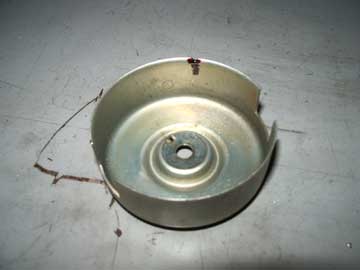|
|
Once you've marked the edge of the cup with a marker you have to make the mark
permanent, so pull the timing plate out again. Remove the bolt from the center
of the timing cup and pull the cup out. This is what you'll see.
|

|
CAUTION!
I want you to pay attention now, dammit! Note that there is a notch in the end
of the shaft, and a tooth on the back of the cup. When you put this thing back
together make sure, REAL sure, that the tooth is set in the notch. That is
what indexes your ignition to the crank, and it is possible to replace the cup
with the tooth not in the notch, then to tighten down the bolt, flattening the
tooth.
|

|
|
The cup will be cocked, though, and it won't fit into the sensors on
the back of the timing plate. That ought to be a clue that something is wrong,
but oh, no . . . some guys can cross-thread a ketchup bottle, and they are the
same ones who'll force stuff until it breaks. This is a likely place for them
to work out.
|

|
Okay; there's the cup with the mark you made right on the very edge. To
make it easier to photograph, and easier for me to work with afterwards, I
drew the mark a little bit on the inside of the cup.
Take a small triangular file or a Dremel tool grinder or something and lightly
notch the edge of the cup - just a little bit will do; don't get carried away,
and be very, very careful not to bend the edge of the cup. Once you have it
notched, find some real bright paint, red or yellow are good, and fill in the
notch. Then a dab of white on either side (which I didn't do, but should have)
will make it stand out real nice.
|
|
Check
again
to be sure your front cylinder is still at TDC. Reinstall the cup (careful,
dammit!), then reinstall the timing plate with the new mark on the cup
showing through the hole you drilled. The hole and the new mark ought to be
lined up with the left post, directly on the imaginary yellow line.
Now, through the magic of modern electronics, you can use a dialback timing
light to set whatever degree of advance you want. Dial that number into the
light, fire up the engine and set it to 2,500RPM, then turn the light on to
the hole. If your engine's real timing matches what you dialed into the light
you will see the new mark on the cup showing through the hole directly beside
the post (which I left out of this picture, but its hole is there).
(
The RPM level is important!
You MUST be running at maximum advance when you time it, and by 2,500RPM most
electronic ignitions are there. With a Crane ignition if you aren't at
2,500RPM you will get increasing advance variations for every bit that you are
off that number in either direction. It matters; make sure.
ALSO - if you do not run a
VOES
you should do whatever your ignition instructions call for to make it advance.
On a Crane, that means ground the green wire from the black box. The
instructions tell you that it should normally be taped off it you don't have a
VOES - if it is, untape and ground it. When you're done, tape it up again.
|

|
|
Once in a while your timing may be out of adjustment enough that you can't see
the mark in the hole. You know it's somewhere around there, but you can't find
it. If you run into that situation (or if you just want to make it easier to
find a wandering mark when you begin this mod) go back to the step shown above
where you've pulled the cup out and marked the edge.
Mark the cup BEFORE you do what I'm about to describe or you'll lose some
accuracy in the mark.
After you've marked the cup, but before you reinstall the
timing plate, extend the hole in in the plate in each direction along the
curve of the cup. You can drill another hole on each side of the one you just
made and file them until all three are one long slot, or you can just file the
first
one until it's as long as you want; doesn't matter which.
Don't make it wider, make it longer. That'll give you more viewing area to
see the mark. Remember, though: when you time it, you want to adjust the mark
until it is
opposite that left-side post, NOT until it's centered in the hole you made.
|
Good luck.
Pilgrim

TOP
|
If you came here from outside Wild West Cycle
and want to see more of the site, click
HERE.
If you came here from within Wild West Cycle
just close this window and you'll be back there.
|
|






